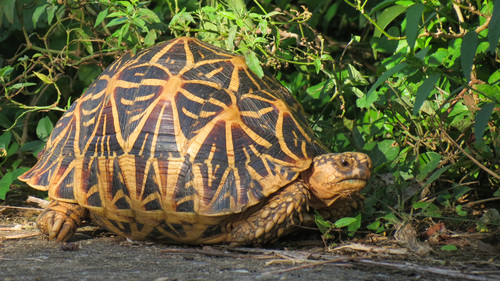
Indian Star Tortoise
The Indian star tortoise, with its mesmerizing star-patterned shell, thrives in arid regions of India and Sri Lanka. This herbivore aids in seed dispersal, making it a keystone species in its ecosystem. Its unique shell design offers camouflage, protecting it from predators.
30-80 years
Lifespan
1.3 - 2.2 kg
Weight
Length: 20 - 30 cm
Size
Brown, Yellow, Black, Tan, Green
Color
0.3 mph
Top Speed
Vulnerable
Conservation Status
Decreasing
Population Trend
Characteristics
The Indian star tortoise (Geochelone elegans) is renowned for its striking star-patterned shell, which provides excellent camouflage in its native dry forest, scrub, and grassland habitats of India and Sri Lanka. These herbivorous reptiles are primarily active during the monsoon season, playing a vital role in seed dispersal.
Distribution Range of the Indian Star Tortoise
Geochelone elegans, commonly known as the Indian star tortoise, is native to the Indian subcontinent. Its geographical distribution includes India, Pakistan, and Sri Lanka. Within India, it is primarily found in the states of Gujarat, Tamil Nadu, and Andhra Pradesh.
Indian Star Tortoise's Habitat
Environmental Conditions
The Indian star tortoise inhabits semi-arid regions, dry forests, and scrublands. It thrives in environments with a warm climate, experiencing hot summers and mild winters. The species typically prefers areas with sparse vegetation, which includes thorny bushes and dry grasses.
Ecological Niche
This species is adapted to environments where it can find shelter among vegetation and rocky outcrops. Its diet mainly consists of grasses, fruits, and flowers, allowing it to play a role in seed dispersal within its ecosystem. The tortoise's unique star-patterned shell provides camouflage against the dappled light of its habitat, offering protection from predators.
Copyright @ Nature Style Limited. All Rights Reserved.
 English
English